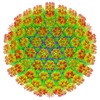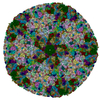[English] 日本語
 Yorodumi
Yorodumi- EMDB-7047: CryoEM structure and atomic model of the Kaposi's sarcoma-associa... -
+ Open data
Open data
- Basic information
Basic information
| Entry | Database: EMDB / ID: EMD-7047 | |||||||||||||||||||||||||||
|---|---|---|---|---|---|---|---|---|---|---|---|---|---|---|---|---|---|---|---|---|---|---|---|---|---|---|---|---|
| Title | CryoEM structure and atomic model of the Kaposi's sarcoma-associated herpesvirus capsid | |||||||||||||||||||||||||||
 Map data Map data | CryoEM structure and atomic model of the Kaposi's sarcoma-associated herpesvirus capsid | |||||||||||||||||||||||||||
 Sample Sample |
| |||||||||||||||||||||||||||
 Keywords Keywords | human herpesvirus 8 / human tumor virus / dsDNA virus capsid assembly / HK97-like fold / VIRUS | |||||||||||||||||||||||||||
| Function / homology |  Function and homology information Function and homology informationT=16 icosahedral viral capsid / viral capsid assembly / viral process / viral capsid / host cell nucleus / structural molecule activity / DNA binding Similarity search - Function | |||||||||||||||||||||||||||
| Biological species |   Human herpesvirus 8 Human herpesvirus 8 | |||||||||||||||||||||||||||
| Method | single particle reconstruction / cryo EM / Resolution: 4.2 Å | |||||||||||||||||||||||||||
 Authors Authors | Dai XH / Gong DY | |||||||||||||||||||||||||||
| Funding support |  United States, 8 items United States, 8 items
| |||||||||||||||||||||||||||
 Citation Citation |  Journal: Nature / Year: 2018 Journal: Nature / Year: 2018Title: Structure and mutagenesis reveal essential capsid protein interactions for KSHV replication. Authors: Xinghong Dai / Danyang Gong / Hanyoung Lim / Jonathan Jih / Ting-Ting Wu / Ren Sun / Z Hong Zhou /  Abstract: Kaposi's sarcoma-associated herpesvirus (KSHV) causes Kaposi's sarcoma, a cancer that commonly affects patients with AIDS and which is endemic in sub-Saharan Africa. The KSHV capsid is highly ...Kaposi's sarcoma-associated herpesvirus (KSHV) causes Kaposi's sarcoma, a cancer that commonly affects patients with AIDS and which is endemic in sub-Saharan Africa. The KSHV capsid is highly pressurized by its double-stranded DNA genome, as are the capsids of the eight other human herpesviruses. Capsid assembly and genome packaging of herpesviruses are prone to interruption and can therefore be targeted for the structure-guided development of antiviral agents. However, herpesvirus capsids-comprising nearly 3,000 proteins and over 1,300 Å in diameter-present a formidable challenge to atomic structure determination and functional mapping of molecular interactions. Here we report a 4.2 Å resolution structure of the KSHV capsid, determined by electron-counting cryo-electron microscopy, and its atomic model, which contains 46 unique conformers of the major capsid protein (MCP), the smallest capsid protein (SCP) and the triplex proteins Tri1 and Tri2. Our structure and mutagenesis results reveal a groove in the upper domain of the MCP that contains hydrophobic residues that interact with the SCP, which in turn crosslinks with neighbouring MCPs in the same hexon to stabilize the capsid. Multiple levels of MCP-MCP interaction-including six sets of stacked hairpins lining the hexon channel, disulfide bonds across channel and buttress domains in neighbouring MCPs, and an interaction network forged by the N-lasso domain and secured by the dimerization domain-define a robust capsid that is resistant to the pressure exerted by the enclosed genome. The triplexes, each composed of two Tri2 molecules and a Tri1 molecule, anchor to the capsid floor via a Tri1 N-anchor to plug holes in the MCP network and rivet the capsid floor. These essential roles of the MCP N-lasso and Tri1 N-anchor are verified by serial-truncation mutageneses. Our proof-of-concept demonstration of the use of polypeptides that mimic the smallest capsid protein to inhibit KSHV lytic replication highlights the potential for exploiting the interaction hotspots revealed in our atomic structure to develop antiviral agents. | |||||||||||||||||||||||||||
| History |
|
- Structure visualization
Structure visualization
| Movie |
 Movie viewer Movie viewer |
|---|---|
| Structure viewer | EM map:  SurfView SurfView Molmil Molmil Jmol/JSmol Jmol/JSmol |
| Supplemental images |
- Downloads & links
Downloads & links
-EMDB archive
| Map data |  emd_7047.map.gz emd_7047.map.gz | 2.8 GB |  EMDB map data format EMDB map data format | |
|---|---|---|---|---|
| Header (meta data) |  emd-7047-v30.xml emd-7047-v30.xml emd-7047.xml emd-7047.xml | 19.9 KB 19.9 KB | Display Display |  EMDB header EMDB header |
| Images |  emd_7047.png emd_7047.png | 300.7 KB | ||
| Filedesc metadata |  emd-7047.cif.gz emd-7047.cif.gz | 7.4 KB | ||
| Archive directory |  http://ftp.pdbj.org/pub/emdb/structures/EMD-7047 http://ftp.pdbj.org/pub/emdb/structures/EMD-7047 ftp://ftp.pdbj.org/pub/emdb/structures/EMD-7047 ftp://ftp.pdbj.org/pub/emdb/structures/EMD-7047 | HTTPS FTP |
-Validation report
| Summary document |  emd_7047_validation.pdf.gz emd_7047_validation.pdf.gz | 735.4 KB | Display |  EMDB validaton report EMDB validaton report |
|---|---|---|---|---|
| Full document |  emd_7047_full_validation.pdf.gz emd_7047_full_validation.pdf.gz | 735 KB | Display | |
| Data in XML |  emd_7047_validation.xml.gz emd_7047_validation.xml.gz | 13.4 KB | Display | |
| Data in CIF |  emd_7047_validation.cif.gz emd_7047_validation.cif.gz | 15.7 KB | Display | |
| Arichive directory |  https://ftp.pdbj.org/pub/emdb/validation_reports/EMD-7047 https://ftp.pdbj.org/pub/emdb/validation_reports/EMD-7047 ftp://ftp.pdbj.org/pub/emdb/validation_reports/EMD-7047 ftp://ftp.pdbj.org/pub/emdb/validation_reports/EMD-7047 | HTTPS FTP |
-Related structure data
| Related structure data |  6b43MC M: atomic model generated by this map C: citing same article ( |
|---|---|
| Similar structure data |
- Links
Links
| EMDB pages |  EMDB (EBI/PDBe) / EMDB (EBI/PDBe) /  EMDataResource EMDataResource |
|---|---|
| Related items in Molecule of the Month |
- Map
Map
| File |  Download / File: emd_7047.map.gz / Format: CCP4 / Size: 7.8 GB / Type: IMAGE STORED AS FLOATING POINT NUMBER (4 BYTES) Download / File: emd_7047.map.gz / Format: CCP4 / Size: 7.8 GB / Type: IMAGE STORED AS FLOATING POINT NUMBER (4 BYTES) | ||||||||||||||||||||||||||||||||||||||||||||||||||||||||||||
|---|---|---|---|---|---|---|---|---|---|---|---|---|---|---|---|---|---|---|---|---|---|---|---|---|---|---|---|---|---|---|---|---|---|---|---|---|---|---|---|---|---|---|---|---|---|---|---|---|---|---|---|---|---|---|---|---|---|---|---|---|---|
| Annotation | CryoEM structure and atomic model of the Kaposi's sarcoma-associated herpesvirus capsid | ||||||||||||||||||||||||||||||||||||||||||||||||||||||||||||
| Projections & slices | Image control
Images are generated by Spider. | ||||||||||||||||||||||||||||||||||||||||||||||||||||||||||||
| Voxel size | X=Y=Z: 1.03 Å | ||||||||||||||||||||||||||||||||||||||||||||||||||||||||||||
| Density |
| ||||||||||||||||||||||||||||||||||||||||||||||||||||||||||||
| Symmetry | Space group: 1 | ||||||||||||||||||||||||||||||||||||||||||||||||||||||||||||
| Details | EMDB XML:
CCP4 map header:
| ||||||||||||||||||||||||||||||||||||||||||||||||||||||||||||
-Supplemental data
- Sample components
Sample components
-Entire : Human herpesvirus 8
| Entire | Name:   Human herpesvirus 8 Human herpesvirus 8 |
|---|---|
| Components |
|
-Supramolecule #1: Human herpesvirus 8
| Supramolecule | Name: Human herpesvirus 8 / type: virus / ID: 1 / Parent: 0 / Macromolecule list: all Details: KSHV lytic replication was induced in an iSLK-puro cell line harboring the KSHV-BAC16 plasmid. NCBI-ID: 37296 / Sci species name: Human herpesvirus 8 / Sci species strain: JSC-1 / Virus type: VIRION / Virus isolate: STRAIN / Virus enveloped: Yes / Virus empty: No |
|---|---|
| Host (natural) | Organism:  Homo sapiens (human) Homo sapiens (human) |
| Molecular weight | Theoretical: 200 MDa |
| Virus shell | Shell ID: 1 / Name: capsid / Diameter: 1300.0 Å / T number (triangulation number): 16 |
-Macromolecule #1: Major capsid protein
| Macromolecule | Name: Major capsid protein / type: protein_or_peptide / ID: 1 / Details: Coded by gene ORF25. / Number of copies: 16 / Enantiomer: LEVO |
|---|---|
| Source (natural) | Organism:   Human herpesvirus 8 Human herpesvirus 8 |
| Molecular weight | Theoretical: 153.574188 KDa |
| Sequence | String: MEATLEQRPF PYLATEANLL TQIKESAADG LFKSFQLLLG KDAREGSVRF EALLGVYTNV VEFVKFLETA LAAACVNTEF KDLRRMIDG KIQFKISMPT IAHGDGRRPN KQRQYIVMKA CNKHHIGAEI ELAAADIELL FAEKETPLDF TEYAGAIKTI T SALQFGMD ...String: MEATLEQRPF PYLATEANLL TQIKESAADG LFKSFQLLLG KDAREGSVRF EALLGVYTNV VEFVKFLETA LAAACVNTEF KDLRRMIDG KIQFKISMPT IAHGDGRRPN KQRQYIVMKA CNKHHIGAEI ELAAADIELL FAEKETPLDF TEYAGAIKTI T SALQFGMD ALERGLVDTV LAVKLRHAPP VFILKTLGDP VYSERGLKKA VKSDMVSMFK AHLIEHSFFL DKAELMTRGK QY VLTMLSD MLAAVCEDTV FKGVSTYTTA SGQQVAGVLE TTDSVMRRLM NLLGQVESAM SGPAAYASYV VRGANLVTAV SYG RAMRNF EQFMARIVDH PNALPSVEGD KAALADGHDE IQRTRIAASL VKIGDKFVAI ESLQRMYNET QFPCPLNRRI QYTY FFPVG LHLPVPRYST SVSVRGVESP AIQSTETWVV NKNNVPLCFG YQNALKSICH PRMHNPTQSA QALNQAFPDP DGGHG YGLR YEQTPNMNLF RTFHQYYMGK NVAFVPDVAQ KALVTTEDLL HPTSHRLLRL EVHPFFDFFV HPCPGARGSY RATHRT MVG NIPQPLAPRE FQESRGAQFD AVTNMTHVID QLTIDVIQET AFDPAYPLFC YVIEAMIHGQ EEKFVMNMPL IALVIQT YW VNSGKLAFVN SYHMVRFICT HMGNGSIPKE AHGHYRKILG ELIALEQALL KLAGHETVGR TPITHLVSAL LDPHLLPP F AYHDVFTDLM QKSSRQPIIK IGDQNYDNPQ NRATFINLRG RMEDLVNNLV NIYQTRVNED HDERHVLDVA PLDENDYNP VLEKLFYYVL MPVCSNGHMC GMGVDYQNVA LTLTYNGPVF ADVVNAQDDI LLHLENGTLK DILQAGDIRP TVDMIRVLCT SFLTCPFVT QAARVITKRD PAQSFATHEY GKDVAQTVLV NGFGAFAVAD RSREAAETMF YPVPFNKLYA DPLVAATLHP L LANYVTRL PNQRNAVVFN VPSNLMAEYE EWHKSPVAAY AASCQATPGA ISAMVSMHQK LSAPSFICQA KHRMHPGFAM TV VRTDEVL AEHILYCSRA STSMFVGLPS VVRREVRSDA VTFEITHEIA SLHTALGYSS VIAPAHVAAI TTDMGVHCQD LFM IFPGDA YQDRQLHDYI KMKAGVQTGP PGNRMDHVGY AAGVPRCENL PGLSHGQLAT CEIIPTPVTS DVAYFQTPSN PRGR AACVV SCDAYSNESA ERLLYDHSIP DPAYECRSTN NPWASQRGSL GDVLYNITFR QTALPGMYSP CRQFFHKEDI MRYNR GLYT LVNEYSARLA GAPATSTTDL QYVVVNGTDV FLDQPCHMLQ EAYPTLAASH RVMLDEYMSN KQTHAPVHMG QYLIEE VAP MKRLLKLGNK VVY UniProtKB: ORF25 |
-Macromolecule #2: Small capsomere-interacting protein
| Macromolecule | Name: Small capsomere-interacting protein / type: protein_or_peptide / ID: 2 / Details: Coded by gene ORF65. / Number of copies: 15 / Enantiomer: LEVO |
|---|---|
| Source (natural) | Organism:   Human herpesvirus 8 Human herpesvirus 8 |
| Molecular weight | Theoretical: 18.597824 KDa |
| Sequence | String: MSNFKVRDPV IQERLDHDYA HHPLVARMNT LDQGNMSQAE YLVQKRHYLV FLIAHHYYEA YLRRMGGIQR RDHLQTLRDQ KPRERADRV SAASAYDAGT FTVPSRPGPA SGTTPGGQDS LGVSGSSITT LSSGPHSLSP ASDILTTLSS TTETAAPAVA D ARKPPSGK KK UniProtKB: Small capsomere-interacting protein |
-Macromolecule #3: Triplex capsid protein 1
| Macromolecule | Name: Triplex capsid protein 1 / type: protein_or_peptide / ID: 3 Details: Coded by gene ORF62. It is the monomer in the heterotrimeric triplex structure. Number of copies: 5 / Enantiomer: LEVO |
|---|---|
| Source (natural) | Organism:   Human herpesvirus 8 Human herpesvirus 8 |
| Molecular weight | Theoretical: 36.37484 KDa |
| Sequence | String: MKVQAENAAR LGRQVLGLLP PPTHRVSLTR GPEFARGVRD LLSKYAASTR PTVGSLHEAL RQAPFRQPTY GDFLVYSQTF SPQEPLGTF LFSFKQEDNG SSMDMLLTPT SLFMLSGMEA AKAPQTHKVA GVWYGSGSGL ADFIPNLSEL MDTGEFHTLL T PVGPMVQS ...String: MKVQAENAAR LGRQVLGLLP PPTHRVSLTR GPEFARGVRD LLSKYAASTR PTVGSLHEAL RQAPFRQPTY GDFLVYSQTF SPQEPLGTF LFSFKQEDNG SSMDMLLTPT SLFMLSGMEA AKAPQTHKVA GVWYGSGSGL ADFIPNLSEL MDTGEFHTLL T PVGPMVQS VHSTFVTKVT SAMKGVGLAR DEPRAHVGLT LPCDMLVDLD ESCPMVQRRE PAGLNVTIYA SLVYLRVNQR PS MALTFFQ SGKGFAEVVA MIKDHFTDVI RTKYIQLRHE LYINRLVFGA VCTLGTVPFD SHPVHQSLNV KGTSLPVLVF ANF EAACGP WTVFL UniProtKB: Core gene UL38 family protein |
-Macromolecule #4: Triplex capsid protein 2
| Macromolecule | Name: Triplex capsid protein 2 / type: protein_or_peptide / ID: 4 Details: Coded by gene ORF26. Forms the dimer in the heterotrimeric triplex structure. Number of copies: 10 / Enantiomer: LEVO |
|---|---|
| Source (natural) | Organism:   Human herpesvirus 8 Human herpesvirus 8 |
| Molecular weight | Theoretical: 34.278473 KDa |
| Sequence | String: MALDKSIVVN LTSRLFADEL AALQSKIGSV LPLGDCHRLQ NIQALGLGCV CSRETSPDYI QIMQYLSKCT LAVLEEVRPD SLRLTRMDP SDNLQIKNVY APFFQWDSNT QLAVLPPLFS RKDSTIVLES NGFDIVFPMV VPQQLGHAIL QQLLVYHIYS K ISAGAPGD ...String: MALDKSIVVN LTSRLFADEL AALQSKIGSV LPLGDCHRLQ NIQALGLGCV CSRETSPDYI QIMQYLSKCT LAVLEEVRPD SLRLTRMDP SDNLQIKNVY APFFQWDSNT QLAVLPPLFS RKDSTIVLES NGFDIVFPMV VPQQLGHAIL QQLLVYHIYS K ISAGAPGD VNMAELDLYT TNVSFMGRTY RLDVDNTDPR TALRVLDDLS MYLCILSALV PRGCLRLLTA LVRHDRHPLT EV FEGVVPD EVTRIDLDQL SVPDDITRMR VMFSYLQSLS SIFNLGPRLH VYAYSAETLA ASCWYSPR UniProtKB: ORF26 |
-Experimental details
-Structure determination
| Method | cryo EM |
|---|---|
 Processing Processing | single particle reconstruction |
| Aggregation state | particle |
- Sample preparation
Sample preparation
| Buffer | pH: 7.4 / Component - Formula: PBS / Component - Name: phosphate buffered saline |
|---|---|
| Grid | Model: Quantifoil R2/1 / Material: COPPER / Mesh: 200 / Support film - Material: CARBON / Support film - topology: HOLEY ARRAY / Pretreatment - Type: PLASMA CLEANING / Pretreatment - Time: 30 sec. / Pretreatment - Atmosphere: OTHER |
| Vitrification | Cryogen name: ETHANE / Chamber temperature: 298 K / Instrument: HOMEMADE PLUNGER Details: The sample was manually blotted and frozen with a homemade plunger.. |
- Electron microscopy
Electron microscopy
| Microscope | FEI TITAN KRIOS |
|---|---|
| Temperature | Min: 79.0 K |
| Image recording | Film or detector model: GATAN K2 SUMMIT (4k x 4k) / Detector mode: SUPER-RESOLUTION / Digitization - Dimensions - Width: 7676 pixel / Digitization - Dimensions - Height: 7420 pixel / Digitization - Frames/image: 1-26 / Number grids imaged: 3 / Number real images: 8007 / Average exposure time: 13.0 sec. / Average electron dose: 25.0 e/Å2 |
| Electron beam | Acceleration voltage: 300 kV / Electron source:  FIELD EMISSION GUN FIELD EMISSION GUN |
| Electron optics | C2 aperture diameter: 70.0 µm / Calibrated magnification: 24271 / Illumination mode: FLOOD BEAM / Imaging mode: BRIGHT FIELD / Cs: 2.7 mm / Nominal defocus max: 2.0 µm / Nominal defocus min: 2.0 µm / Nominal magnification: 14000 |
| Sample stage | Specimen holder model: FEI TITAN KRIOS AUTOGRID HOLDER / Cooling holder cryogen: NITROGEN |
| Experimental equipment |  Model: Titan Krios / Image courtesy: FEI Company |
 Movie
Movie Controller
Controller












 Z (Sec.)
Z (Sec.) Y (Row.)
Y (Row.) X (Col.)
X (Col.)





















